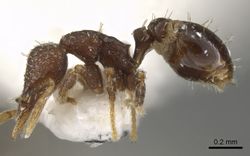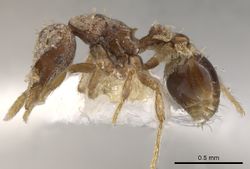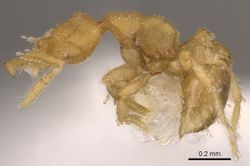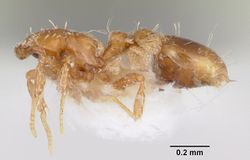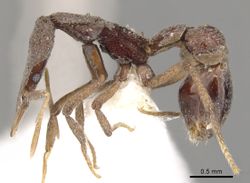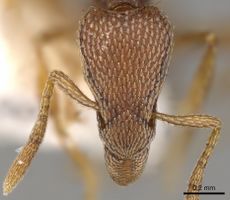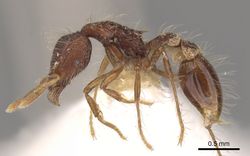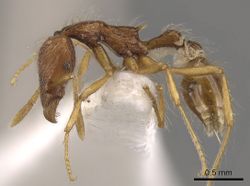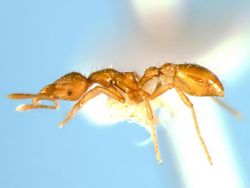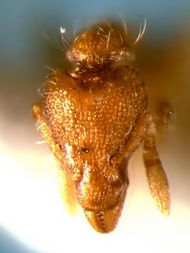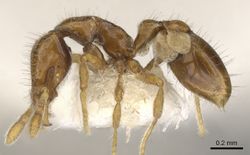Key to Strumigenys of East Asia (as Pyramica)
This key to species of Strumigenys known from East Asia is based on Barry Bolton's revision of the tribe Dacetini (Bolton, 2000).
When written, these species were placed in the genus Pyramica, which is now a junior synonym of Strumigenys. As a result, species from this region are found in two keys, this one and a Key to Strumigenys of East Asia.
Note that Strumigenys formosa of Taiwan, known only from queens, is omitted from the key. Its workers would be expected to key out around couplets 26-27.
Tang & Guenard (2023) provide a significant overhaul of this key, replacing couplets 37–56. New species described since the publication of the original key, which would be keyed out around the above couplets, are included. This includes all known East Asian species from the S. acubecca-, S. bubisnoda-, S. leptothrix-, S. nathistorisoc-, S. semicompta- and S. wilsoniana-groups. Some of the couplets are only slightly modified from the original. As more than two dozen of species are added, the original couplet numberings are not retained and the original couplets numbered 37 to 56 are replaced with couplets numbered T&G1 to T&G-34.
1
- Antenna with 4 segments; first funicular segment not separated from the 2-segmented apical club. (India, Nepal, Thailand, Malaysia (West Malaysia), Singapore) . . . . . Strumigenys nepalensis
- Antenna with 5 or 6 segments; first funicular segment separated from the 2-segmented apical club by one or two small segments . . . . . 2
2
return to couplet #1
- Antenna with 5 segments; first funicular segment separated from the 2-segmented apical club by a single small segment. (Malaysia (West Malaysia)) . . . . . Strumigenys gyges
- Antenna with 6 segments; first funicular segment separated from the 2-segmented club by two small segments . . . . . 3
3
return to couplet #2
- With head in full-face view the leading edge of the scape with a row of conspicuous projecting curved hairs, of which one or more, distal to the subbasal bend, distinctly curves toward the base of the scape. These hairs may be spatulate, remiform, spoon-shaped or broadly clavate apically; basal stem of each hair (which may be short) erect or sub erect with respect to the long axis of the scape . . . . . 4
- With head in full-face view the leading edge of the scape lacking projecting hairs that curve toward the base of the scape. Scape edge may have elongate simple straight projecting hairs present, or entirely apically directed short hairs that may be simple, narrowly to broadly spatulate, or spoon-shaped; in some species the leading edge may be hairless . . . . . 35
4
return to couplet #3
- With head in full-face view the dorsolateral margin with a distinctly isolated, very conspicuous, laterally projecting apicoscrobal hair; apicoscrobal hair conspicuously differentiated from other pilosity on the margin, may be simple, clavate or flagellate . . . . . 5
- With head in full-face view the dorsolateral margin without a distinctly isolated apicoscrobal hair that is conspicuously differentiated from other pilosity on the margin; either hair absent or duplicated by others on the margin . . . . . 23
5
return to couplet #4
- Pronotal humeral hair absent. Dorsum of pronotum densely clothed with scale-like or stud-like broad hairs. Ventral margin of petiole peduncle without a longitudinal spongiform strip from base to level of node. Base of first gastral sternite without spongiform tissue. Standing stout hairs on first gastral tergite restricted to a single transverse row of four extremely close to the base. (Malaysia (Sarawak)) . . . . . Strumigenys clotho
- Pronotal humeral hair present, may be simple, clavate, remiform or flagellate. Dorsum of pronotum lacking scale-like or stud-like broad hairs. Ventral margin of petiole peduncle with a continuous longitudinal spongiform strip from base to level of node, even if only narrowly so. Base of first gastral sternite with spongiform tissue. Standing hairs on first gastral tergite not restricted to a single transverse row close to the base . . . . . 6
6
return to couplet #5
- Pronotal humeral hair long and flagellate; either freely projecting, or with its apical portion looped . . . . . 7
- Pronotal humeral hair not flagellate; either simple and shallowly curved, or narrowly clavate, or remiform . . . . . 10
7
return to couplet #6
- Cephalic dorsum with a transverse row of 4 standing hairs immediately in front of the occipital margin, but without a similar pair in front of the highest point of the vertex. Apicoscrobal hair not flagellate . . . . . 8
- Cephalic dorsum with a transverse row of 4 standing hairs immediately in front of the occipital margin, and with a pair of similar standing hairs just in front of the highest point of the vertex. Apicoscrobal hair flagellate . . . . . 9
8
return to couplet #7
- Eye minute, with only 1 or 2 very small ommatidia. Mesopleuron and metapleuron, and side of propodeum, smooth and shining. (Malaysia (West Malaysia)) . . . . . Strumigenys vescops
- Eye larger, distinctly with more than 2 ommatidia. Mesopleuron smooth but metapleuron and side of propodeum reticulate-punctate. (Marquesas Is) . . . . . Strumigenys mumfordi
9
return to couplet #7
- Mesonotum in profile with a single pair of erect long stout hairs, situated anteriorly on the sclerite. (Malaysia (West Malaysia, Sabah), Philippines (Luzon), Indonesia (Bali, Sumatra, Sulawesi, Kai Besar, Aru), Papua New Guinea, Solomon Is, Palau Is, also present in Australia) . . . . . Strumigenys karawajewi
- Mesonotum in profile with two pairs of erect long stout hairs, the posterior pair usually distinctly the longer. (Bhutan, China, Burma, Thailand, Malaysia (West Malaysia, Sarawak, Sabah), Philippines (Luzon), Indonesia (Kalimantan, Bali, Java, Sumatra)) . . . . . Strumigenys dohertyi
10
return to couplet #6
- Apical (masticatory) margin of mandible finely serrate, with distinctly more than 20 small to minute denticles crowded along the margin; basal 5-7 teeth not large and not the only ones clearly visible when the mandibles are fully closed . . . . . 11
- Apical (masticatory) margin of mandible dentate, with 1 2 teeth and denticles in total on the margin; basal 5-7 teeth relatively large and the only ones clearly visible when the mandibles are fully closed . . . . . 12
11
return to couplet #10
- First gastral tergite behind level of basigastral costulae (when clean) finely and densely coriaceous; the same sculpture also present on apical half of first gastral sternite. Disc of postpetiole not uniformly sharply reticulate-punctate. (Indonesia (Sulawesi)) . . . . . Strumigenys serraformis
- First gastral tergite behind level of basigastral costulae (when clean), and first gastral sternite, glassy smooth and highly polished, without coriaceous sculpture. Disc of postpetiole very uniformly sharply reticulate-punctate. (Philippines (Luzon)) . . . . . Strumigenys serradens
12
return to couplet #10
- With head in full-face view the outer margins of the mandibles shallowly concave behind the apical third; the mandibles relatively long, MI 35-36. Anterior face of petiole node in profile more or less continuing the line of the peduncle in a sinuous curve, the two not separated by a marked angle. (Indonesia (Sulawesi)) . . . . . Strumigenys rhea
- With head in full-face view the outer margins of the mandibles evenly shallowly convex; the mandibles relatively short, MI 21-29. Anterior face of petiole node in profile separated from the line of the peduncle by a marked obtuse angle . . . . . 13
13
return to couplet #12
- In dorsal view the disc of the postpetiole smooth and shining (when clean), without reticulate-punctate or punctate-rugulose sculpture, without trace of longitudinal costulae or at most with vestigial sculpture. If sculpture vestiges present then HW < 0.50 . . . . . 14
- In dorsal view the disc of the postpetiole sculptured, either reticulate-punctate, punctate-rugulose, or finely densely and usually sharply longitudinally costulate across most or all of its surface. If sculpture partially effaced then HW 0.50 or greater . . . . . 20
14
return to couplet #13
- Pronotal humeral hair elongate and gradually tapering to an acute apex. With waist segments in dorsal view the petiole node shining, similar to the disc of the postpetiole. SI ca 67, CI ca 75 . (Tahiti) . . . . . Strumigenys insula
- Pronotal humeral hair stout, truncated-remiform or weakly clavate apically. With waist segments in dorsal view the petiole node reticulate-punctate, contrasting strongly with the smooth disc of the postpetiole. SI 50-60, CI 78-94 . . . . . 15
15
return to couplet #14
- Side of pronotum obliquely costulate. Metapleuron and side of propodeum longitudinally costulate. Ventral spongiform strip of petiole reduced to a carina-like vestige beneath the peduncle. (Papua New Guinea) . . . . . Strumigenys tethys
- Side of pronotum partially to entirely reticulate-punctate. Metapleuron and side of propodeum mostly smooth to entirely reticulate-punctate, never costulate. Ventral spongiform strip of petiole distinct beneath the peduncle . . . . . 16
16
return to couplet #15
- Alitrunk in profile with dorsal outline evenly sloping downwards posteriorly, usually at an angle of about 45 0, from anterior mesonotum to propodeal tooth; without an impressed metanotal groove and without a change of slope between mesonotum and propodeum. Head broad, CI > 90. Alitrunk short and stocky, the pronotum broad; AL < 1.50 X maximum alitrunk height, AL about 1.70 X pw. (Papua New Guinea) . . . . . Strumigenys phasma
- Alitrunk in profile with dorsal outline not evenly sloping downwards from anterior mesonotutn to propodeal tooth; either mesonotum and propodeum form separate convexities, or metanotal groove distinctly impressed, or with a marked change of slope between mesonotum and propodeum. Head narrower, CI 79-89. Alitrunk longer and narrower; AL > 1.50 X maximum alitrunk height, AL 1.80-2.00 X PW . . . . . 17
17
return to couplet #16
- Mesonotal dorsum with a single pair of stout standing hairs . . . . . 18
- Mesonotal dorsum with two pairs of stout standing hairs . . . . . 19
18
return to couplet #17
- Disc of petiole node in dorsal view much broader than long, transversely rectangular. Postpetiole massively developed in dorsal view, its disc conspicuously twice broader than long and twice as broad as the petiole node. Dark brown to black species with MI 26-27. (Fiji Is) . . . . . Strumigenys trauma
- Disc of petiole node in dorsal view at most only fractionally broader than long, not transversely rectangular. Postpetiole relatively small in dorsal view, its disc distinctly less than twice broader than long, less than twice as broad as the petiole node. Light reddish-brown species with MI 21-22. (Samoa) . . . . . Strumigenys epipola
19
return to couplet #17
- In dorsal view sides of petiole and postpetiole not entirely margined with projecting spongiform tissue. Ventral spongiform lobe of postpetiole in profile smaller than the exposed area of the postpetiole disc. With alitrunk in profile the propodeal dorsal outline markedly convex behind the metanotal groove. Yellow to light yellowish brown species with MI 25-29. (Indonesia (Sulawesi), Papua New Guinea) . . . . . Strumigenys themis
- In dorsal view sides of both petiole and postpetiole thickly margined with projecting spongiform tissue. Ventral spongiform lobe of postpetiole in profile distinctly larger than the exposed area of the postpetiole disc. With alitrunk in profile the propodeal dorsal outline approximately flat and sloping posteriorly behind the metanotal groove. Darker reddish brown species with MI 2 1 . (Indonesia (Sumatra)) . . . . . Strumigenys charybdis
20
return to couplet #13
- Leading edge of scape in dorsal view with subbasal bend developed into a projecting triangular flattened tooth before its narrow basal section (longest hair on margin arises from apex of this tooth). Very large species with head very broad, HW > 0.90, CI 97-101. (Papua New Guinea) . . . . . Strumigenys dentiscapa
- Leading edge of scape in dorsal view with subbasal bend broadly shallowly and evenly convex before its narrow basal section. Markedly smaller species with narrower heads, HW 0.50-0.62, CI 80-89 . . . . . 21
21
return to couplet #20
- Sides of alitrunk entirely sharply reticulate-punctate, without smooth unsculptured areas. Dorsum of mesonotum with 3 (or rarely 4) pairs of stout standing hairs. (Malaysia (Sabah)) . . . . . Strumigenys theia
- Sides of alitrunk not entirely reticulate-punctate, with smooth un sculptured areas on mesopleuron, metapleuron, or propodeum. Dorsum of mesonotum with 2 pairs of standing hairs . . . . . 22
22
return to couplet #21
- With petiole in profile the dorsal length of the node, discounting the posterior collar, greater than the height of the anterior face of the node; petiole node in dorsal view usually longer than broad. With postpetiole in profile the ventral spongiform lobe at least equal in area to the exposed portion of the disc. (Malaysia (West Malaysia), Philippines (Luzon, Negros) . . . . . Strumigenys pedunculata
- With petiole in profile the dorsal length of the node, discounting the posterior collar, subequal to the height of the anterior face of the node; petiole node in dorsal view broader than long. With postpetiole in profile the ventral spongiform lobe much smaller in area than the exposed portion of the disc. (Indonesia (Sulawesi, Seram), Papua New Guinea) . . . . . Strumigenys capitata
23
return to couplet #4
- Mandibles elongate and narrow, linear; in full-face view and at full closure only their extreme apices engage. Leading edge of scape with a large, strongly prominent subbasal lobe . . . . . 24
- Mandibles sub triangular to triangular, not linear; in full-face view and at full closure they engage for half or more of their exposed length. Leading edge of scape with a gradual subbasal curve or subbasal angle, without a large, strongly prominent subbasal lobe . . . . . 28
24
return to couplet #23
- Mandible without preapical teeth. Pronotal dorsum covered with numerous large flat orbicular hairs. Cephalic dorsum without a transverse blunt ridge or crest across highest point of vertex. Dorsum of mandible not abruptly depressed near base where it passes beneath the anterior clypeal margin . . . . . 25
- Mandible with 2 or more preapical teeth. Pronotal dorsum not covered with large orbicular hairs. Cephalic dorsum with a transverse blunt ridge or crest across highest point of vertex. Dorsum of mandible abruptly depressed near base where it passes beneath the anterior clypeal margin . . . . . 26
25
return to couplet #24
- Dorsal surface of mandible without longitudinal rows of anteriorly directed spoon-shaped or scale-like hairs. The two pairs of hairs closest to the midline on the anterior clypeal margin short, narrowly spoon-shaped and curved or inclined toward the midline. Orbicular hairs on clypeus all of approximately the same size. (Japan, Taiwan) . . . . . Strumigenys hirashimai
- Dorsal surface of mandible with two longitudinal rows of anteriorly directed spoon-shaped or scale-like hairs. The two pair of hairs closest to the midline on the anterior clypeal margin long and strap-like, directed anteriorly and curved slightly away from the midline. Orbicular hairs on clypeus much smaller centrally than near lateral and posterior margins. (China) . . . . . Strumigenys lachesis
26
return to couplet #24
- Eyes absent. Cephalic dorsum without small orbicular hairs. (Nepal) . . . . . Strumigenys hemisobek
- Eyes present but minute, of only 1 or 2 ommatidia. Cephalic dorsum with small orbicular hairs, at least immediately behind the clypeus . . . . . 27
27
return to couplet #26
- Small orbicular hairs on head restricted to 2 transverse rows immediately behind the clypeus. Apicodorsal tooth of mandible short, at full closure not crossing over beyond the outer margin of the opposing mandible. Pronotal dorsum with longitudinal costulate sculpture. (Malaysia (Sarawak), Indonesia (Sulawesi)) . . . . . Strumigenys dyschima
- Small orbicular hairs on head present from immediately behind clypeus to the arched transverse crest across the highest point of the vertex. Apicodorsal tooth of mandible very long and spiniform, at full closure crossing over beyond the outer margin of the opposing mandible. Pronotal dorsum reticulate-punctate. (Malaysia (West Malaysia)) . . . . . Strumigenys murphyi
28
return to couplet #23
- Pronotal humeral hair absent . . . . . 29
- Pronotal humeral hair present; may be simple, flagellate, remiform or subclavate . . . . . 31
29
return to couplet #28
- Fully closed mandibles in full-face view with crowded series of small teeth on the distal halves of the masticatory margins, but the proximal halves are edentate and concave, and enclose a broad subovate gap in front of the anterior clypeal margin. (Taiwan) . . . . . Strumigenys takasago
- Fully closed mandibles in full-face view with teeth extending from apex of masticatory margin to the point where the margin intersects the anterior clypeal margin . . . . . 30
30
return to couplet #29
- Entire mesopleuron and metapleuron blanketed with dense reticulate-punctate sculpture, without smooth shining areas. Petiole ventrally with a vestigial cuticular strip, not spongiform. First gastral tergite with numerous short curved spatulate hairs on the basal half, such hairs absent from apical half of sclerite. (Malaysia (Sabah)) . . . . . Strumigenys disjuncta
- Entire mesopleuron and metapleuron smooth and shining, not blanketed with reticulate-punctate sculpture. Petiole ventrally with a deep spongiform curtain. First gastral tergite with sparse minute appressed pubescence only. (Cosmopolitan tramp species) . . . . . Strumigenys membranifera
31
return to couplet #28
- Cephalic dorsum in full-face view with very conspicuous broad spoon-shaped to suborbicular ground-pilosity . . . . . 32
- Cephalic dorsum in full-face view with slender narrowly spatulate ground pilosity . . . . . 33
32
return to couplet #31
- Cephalic dorsum with a transverse row of four stiff erect hairs near occipital margin, these hairs contrasting strongly with the ground-pilosity. Dorsal (outer) surface of hind basitarsus with 1-2 very long fine erect flagellate hairs. Leading edge of scape distal of the subbasal angle with 3 or more hairs that are curved toward the base of the scape. (Thailand, Malaysia (West Malaysia)) . . . . . Strumigenys atropos
- Cephalic dorsum without stiff erect hairs near occipital margin that contrast with the ground-pilosity. Dorsal (outer) surface of hind basitarsus without flagellate hairs. Leading edge of scape distal of the subbasal angle with only a single hair that is curved toward the base of the scape. (Japan) . . . . . Strumigenys hiroshimensis
33
return to couplet #31
- Pronotal humeral hair fine, flagellate. Longest pair of hairs on dorsum of mesonotum fine and simple . . . . . 34
- Pronotal humeral hair stout, simple to weakly remiform. Longest pair of hairs on dorsum of mesonotum stout, remiform to subclavate. (Japan) . . . . . Strumigenys rostrataeformis
34
return to couplet #33
- Anterior clypeal margin distinctly concave in full-face view. Lateral margins of occipital lobes in full-face view with all hairs short stout and curved, without longer finer sub flagellate hairs. (Korea, Japan) . . . . . Strumigenys incerta
- Anterior clypeal margin transverse or even shallowly convex in full-face view. Lateral margins of occipital lobes in full-face view with a mixture of shorter curved hairs and longer finer subflagellate hairs. (China) . . . . . Strumigenys emeswangi
35
return to couplet #3
- Spongiform tissue of body enormously developed. In profile the petiole node and postpetiole disc appear to consist entirely of spongiform tissue, which also blankets the propodeum, metapleuron and dorsal rim of the mesonotum. (Brunei, Malaysia (Sarawak)) . . . . . Strumigenys kempfi
- Spongiform tissue much less abundant. In profile the petiole node and postpetiole disc are visible, spongiform tissue is represented by lateral lobes and anterior and posterior collars on each segment; propodeum, metapleuron and mesonotum free from spongiform tissue although the lamellae of the propodeal declivity may sometimes be spongiform . . . . . 36
36
return to couplet #35
- Petiole node in profile long and low; either anterior face of node much shorter than the long dorsum, or the anterior face shallowly sloped and grading evenly into the peduncle so that the entire segment is subclavate. Petiole node in dorsal view long and narrow, sometimes with a posterior peduncle, always much longer than broad and generally at least equal in length to the disc of the postpetiole . . . . . T&G-1
- Petiole node in profile short and relatively high; either anterior face of node at least subequal in length to the dorsum, or the anterior face steeply sloped and meeting the peduncle through an obtuse but marked angle, or both. Petiole node in dorsal view short and broad, usually at least as broad as long and generally shorter than the disc of the postpetiole . . . . . 57
T&G-1
return to couplet #36
- (Couplet 37 of the original key) Mandibles elongate and narrow in full-face view; masticatory margins engage only in apical half or less of their length at full closure, proximally with large gap between mandibles; labral lobes visible through gap; MI > 25 => T&G-2
- Mandibles triangular to elongated-triangular in full-face view; masticatory margins engage throughout their length at full closure, proximally without large gap between mandibles; labral lobes not visible; MI < 25 => T&G-4
T&G-2
return to couplet #T&G-1
- When fully-closed, mandibles entirely dentate from base to apex in full-face view; teeth range from triangular, spiniform to broad and rounded (Mainland China) => Strumigenys nathistorisoc
- When fully-closed, mandibles edentate from base to about the mid-length in full-face view; teeth triangular and spiniform, without broad and rounded tooth => T&G-3
T&G-3
return to couplet #T&G-2
- Flagellate setae present on dorsolateral margins of head, pronotal humeri, petiole, postpetiole, fi rst gastral tergite and dorsal (outer) surfaces of tibiae and basitarsi. Aligned rows of appressed spatulate setae entirely absent. Anterior clypeal margin with small median tooth. Eye minute, with only 3–4 ommatidia in total. Scape long and slender, SI > 100. (Malaysia (Peninsular)) => Strumigenys acubecca
- Flagellate setae entirely absent. Aligned rows of appressed spatulate setae conspicuous on cephalic dorsum, scapes and mandibles. Anterior clypeal margin evenly convex. Eye relatively large, with 5 ommatidia in longest row. Scape short and stout, SI < 70. (Mainland China) => Strumigenys wilsoniana
T&G-4
return to couplet #T&G-1
- Masticatory margin of mandible with total dental count of 5; all stoutly conical and slightly recurved teeth, without denticles. Anterior clypeal margin transverse or nearly so. Apices of labral lobes truncated => T&G-5
- Masticatory margin of mandible with total dental count of 12–18; with basal series of 6–9 teeth that may be elongated-triangular, broad and rounded, conical or spiniform; distal to this series number of smaller teeth and denticles. Anterior clypeal margin convex. Apices of labral lobes may be triangular, conical or digitate, but never truncated => T&G-7
T&G-5
return to couplet #T&G-4
- Dorsal (outer) surfaces of middle and hind tibiae and basitarsi with numerous erect long simple setae. Dorsal surfaces of middle and hind femora with suberect to erect elongate simple setae. Leading edge of scape with row of short suberect clavate setae. Basigastral costulae extend for some distance onto sclerite proper, not restricted to limbus. (Indonesia (Maluku Islands), Papua New Guinea, also present in Australia) => Strumigenys semicompta
- Dorsal (outer) surfaces of middle and hind tibiae and basitarsi with short decumbent to appressed setae. Dorsal surfaces of middle and hind femora without elongate simple setae. Leading edge of scape with row of closely appressed minute setae. Basigastral costulae extremely short, traversing limbus but barely extending onto sclerite proper => T&G-6
T&G-6
return to couplet #T&G-5
- Cephalic dorsum behind clypeus entirely sculptured, with longitudinal rugulae present. Dorsolateral margin of occipital lobe with 3 short stiff projecting setae; dorsum of head with a few erect short setae near occipital margin. Pronotal humeral seta present, stiff and projecting laterally. Dorsal mesosoma with short erect setae present along dorsolateral margins. (Papua New Guinea) => Strumigenys carnassa
- Cephalic dorsum behind clypeus mostly smooth, without longitudinal rugulae. Dorsolateral margin of occipital lobe without projecting setae; dorsum of head without erect setae. Pronotal humeral seta absent. Dorsal mesosoma without erect setae anywhere. (Indonesia (New Guinea)) => Strumigenys pydrax
T&G-7
return to couplet #T&G-4
- Postpetiole enormously infl ated, PPL 0.42. Larger species, HL 1.22. Head in profile extremely dorsoventrally fl attened, its depth at level of eye only slightly greater than maximum diameter of eye. Propodeal spiracle located at apex of V-shaped depression inside sclerite. (Malaysia (East Malaysia)) => Strumigenys bubisnoda
- Postpetiole small, PPL < 0.3. Smaller species, HL < 0.90. Head in profile not dorsoventrally flattened, its depth at level of eye much greater than maximum diameter of eye. Propodeal spiracle not located at apex of a V-shaped depression inside sclerite => T&G-8
T&G-8
return to couplet #T&G-7
- In profile view, propodeal declivity with simple carina, or at most narrow lamella with posterior margin close to and parallel with edge of declivity => T&G-9
- In profile view, propodeal declivity with broad lamella, posterior margin not close to nor parallel with edge of declivity => T&G-17
T&G-9
return to couplet #T&G-8
- Dorsal (outer) surface of hind tibia without suberect to erect projecting setae; any setae present are decumbent to appressed => T&G-10
- Dorsal (outer) surface of hind tibia with suberect to erect projecting setae => T&G-14
T&G-10
return to couplet #T&G-9
- Propodeal lobes (at base of declivity) elongate, narrowly acutely triangular. Declivity above propodeal lobe margined only by vestigial carina extending upward to propodeal spine => T&G-11
- Propodeal lobes (at base of declivity) short, low and rounded. Declivity above propodeal lobe margined by narrow lamella distinctly engaging base of propodeal tooth or spine => T&G-13
T&G-11
return to couplet #T&G-10
- With head in profile view, dorsal outline of clypeus forming shallow even convexity with highest point at about mid-length; clypeal outline sloping evenly and gently upward from basal margin of mandible to highest point and posterior to this sloping evenly and gently downward to posterior clypeal apex => T&G-12
- With head in profile view, dorsal outline of clypeus not forming even shallow convexity with highest point at about mid-length; clypeal outline rising almost vertically from basal margin of mandible and passing through bluntly bulging angle (vertical portion accounts for about onethird of length of outline), posterior to this outline almost fl at to posterior clypeal apex. (East Malaysia) => Strumigenys megaera
T&G-12
return to couplet #T&G-11
- With head in profile view, dorsum with single transverse row of 4–6 short standing setae posteriorly, immediately in front of occipital margin. In full-face view dorsolateral margin of occipital lobe without freely projecting stiff setae. Head narrower and scape longer, CI 56–60, SI 81–86. (Thailand) => Strumigenys scolopax
- With head in profile view, dorsum with numerous standing setae posteriorly, obviously more than single row immediately in front of occipital margin. In full-face view dorsolateral margin of occipital lobe with 4–5 freely projecting stiff setae. Head broader and scape shorter, CI 65–70, SI 71–77. (Malaysia (Peninsular), Indonesia (Java)) => Strumigenys rudinodis
T&G-13
return to couplet #T&G-10
- Side of pronotum, mesopleuron, metapleuron and side of propodeum entirely smooth and shining; pronotum strongly marginated dorsolaterally (Vietnam) => Strumigenys rongi
- Side of pronotum and propodeum entirely sculptured, mesopleuron and metapleuron only partly smooth and shining; pronotum at most weakly marginated dorsolaterally (Mainland China, Korea, Japan, Taiwan) => Strumigenys japonica
T&G-14
return to couplet #T&G-9
- With head in full-face view, upper scrobe margin with continuous row of short anteriorly directed decumbent to appressed setae only, without elongate setae freely projecting beyond margins; one or two freely projecting setae may occur on lateral occipital lobes well behind level of eyes. (Malaysia (East Malaysia), Philippines) => Strumigenys euryale
- With head in full-face view, upper scrobe margins with straight or curved elongate setae freely projecting laterally or dorsolaterally beyond margins; similar or even longer setae project from occipital lobes => T&G-15
T&G-15
return to couplet #T&G-14
- Leading edge of antennal scape with series of straight anteriorly projecting setae; dorsum of petiolar node unsculptured (Indonesia (Sulawesi)) => Strumigenys stheno
- Leading edge of antennal scape without series of straight anteriorly projecting setae; dorsum of petiolar node fully sculptured => T&G-16
T&G-16
return to couplet #T&G-15
- Propodeal lobes elongate and narrowly triangular, more than half length of propodeal spines. Elongate setae on dorsum of head erect in profile view, weakly curved or sinuate along their length but not strongly arched forward. Pronotal dorsum with spaces between longitudinal costulae vestigially punctulate to smooth. (Malaysia (East Malaysia)) => Strumigenys medusa
- Propodeal lobes short and broadly triangular, much less than half length of propodeal spines. Elongate setae on dorsum of head strongly arching forward in profile view, their apices directed anteriorly. Pronotal dorsum with spaces between the longitudinal costulae densely reticulate-punctate. (Papua New Guinea, Philippines) => Strumigenys scylla
T&G-17
return to couplet #T&G-8
- Dorsal (outer) surface of hind tibia without suberect to erect projecting setae; any setae present are decumbent to appressed => T&G-18
- Dorsal (outer) surface of hind tibia with suberect to erect projecting setae => T&G-23
T&G-18
return to couplet #T&G-17
- Dorsal mesosoma entirely lacking standing setae => T&G-19
- Dorsal mesosoma with standing setae present at least on the mesonotum => T&G-20
T&G-19
return to couplet #T&G-18
- With petiole in profile view, lateral spongiform lobe very broad and extending forward to level of spiracle on peduncle. Propodeal spines or teeth absent. (Mainland China, India, Vietnam) => Strumigenys assamensis
- With petiole in profile view, lateral spongiform lobe not extending forward to level of spiracle on peduncle. Propodeum with pair of spines or acute teeth. (Mainland China) => Strumigenys zanderi
T&G-20
return to couplet #T&G-18
- With head in full-face view, dorsolateral margin of head strongly marginated; lateral margin of occipital lobe and upper scrobe margin forming blunt angle. Pronotum marginated dorsolaterally. (Thailand) => Strumigenys decumbens
- With head in full-face view, dorsolateral margin of head at most weakly marginated; lateral margin of occipital lobe and upper scrobe margin meeting as continuous curve and not forming blunt angle. Pronotum not marginated dorsolaterally => T&G-21
T&G-21
return to couplet #T&G-20
- With head in full-face view, lateral margin of occipital lobe with numerous long setae freely projecting beyond margins => T&G-22
- With head in full-face view, lateral margin of occipital lobe without any setae freely projecting beyond margins. (Korea) => Strumigenys calvus
T&G-22
return to couplet #T&G-21
- Pronotal dorsum with numerous long erect simple setae. (Taiwan) => Strumigenys formosimonticola
- Pronotal dorsum without long erect simple setae. (Japan, Taiwan) => Strumigenys benten
T&G-23
return to couplet #T&G-17
- In profile view, mesosoma with numerous erect long setae => T&G-24
- In profile view, erect setae on mesosoma either short and stubbly, or limited to a few pairs on the mesonotum only => T&G-26
T&G-24
return to couplet #T&G-23
- With head in full-face view, clypeus entirely covered with scale-like obovate setae. Pronotal dorsum entirely smooth and shining. (Taiwan) => Strumigenys yamanei
- With head in full-face view, clypeus with stout and truncated or narrowly elliptic setae only, not scale-like obovate. Pronotal dorsum fully sculptured => T&G-25
T&G-25
return to couplet #T&G-24
- Leading edge of antennal scape with series of straight anteriorly projecting simple setae. Side of mesosoma entirely smooth and shining. Petiole with differentiated short anterior face. (Mainland China, Japan, Taiwan) => Strumigenys leptothrix
- Leading edge of antennal scape without series of straight anteriorly projecting simple setae. Side of mesosoma mostly sculptured. Petiolar peduncle grading evenly into node, petiole without differentiated short anterior face. (Indonesia (Borneo, Sumatra), Malaysia, Philippines, Vietnam) => Strumigenys jacobsoni
T&G-26
return to couplet #T&G-23
- Dorsum of head with suberect to erect setae only; appressed setae, if any, limited to clypeal dorsum only. (Vietnam) => Strumigenys strummeri
- Dorsum of head has both appressed and erect setae, appressed setae not limited to clypeal dorsum => T&G-27
T&G-27
return to couplet #T&G-26
- Side of mesosoma entirely smooth and shining => T&G-28
- Side of mesosoma mostly or entirely sculptured => T&G-29
T&G-28
return to couplet #T&G-27
- In profile view, erect setae on mesosoma long and stout; propodeal lamellae relatively broad, broadest part slightly broader than maximum width of middle femur. Pronotum strongly marginated dorsolaterally. (Mainland China) => Strumigenys zhenghuii
- In profile view, erect setae on mesosoma short and stubbly; propodeal lamellae relatively narrow, widest part much narrower than maximum width of middle femur. Pronotum at most weakly marginated dorsolaterally. (Japan, Korea) => Strumigenys alecto
T&G-29
return to couplet #T&G-27
- With head in profile view, dorsum without any erect seta. In full-face view, cephalic dorsum with appressed, distinctly spatulate setae; laterally-projecting setae limited to at most 1–2 around the occipital corner. (Mainland China, Thailand, Vietnam) => Strumigenys doydeei
- With head in profile view, the dorsum with erect setae. In full-face view, cephalic dorsum with appressed fi ne, stout, plank-like or subspatulate setae, not distinctly spatulate; at least 4–5 laterally projecting setae on lateral margin of occipital lobe => T&G-30
T&G-30
return to couplet #T&G-29
- With head in profile view, erect setae on the dorsum restricted to area between highest point of the vertex and the occipital margin => T&G-31
- With head in profile view, erect setae present sporadically across dorsum, not restricted to area between highest point of vertex and occipital margin => T&G-34
T&G-31
return to couplet #T&G-30
- Pronotal dorsum predominantly, strongly longitudinally or transversely striated => T&G-32
- Pronotal dorsum areolate-rugulose (reticulate-punctate), sometimes with weak longitudinal striation, not predominantly longitudinally or transversely striated => T&G-33
T&G-32
return to couplet #T&G-31
- Pronotal dorsum predominantly, strongly longitudinally striated. (Mainland China) => Strumigenys ailaoshana
- Pronotal dorsum predominantly, strongly transversely striated. (Mainland China) => Strumigenys nankunshana
T&G-33
return to couplet #T&G-31
- With head in full-face view, appressed setae different in shape between dorsum and clypeus, plank-like to subspatulate setae on dorsum, and narrowly elliptic on clypeus. (Mainland China, Taiwan, Thailand) => Strumigenys elegantula
- With head in full-face view, appressed setae similar in shape in both dorsum and clypeus, consistently stout and truncated. (Mainland China) => Strumigenys densissima
T&G-34
return to couplet #T&G-30
- With head in full-face view, appressed setae on dorsum fi ne and apically-acute; lateral margin of occipital lobe with more than 7 laterally-projecting setae. (Thailand) => Strumigenys delicata
- With head in full-face view, appressed setae on dorsum stout and truncated; lateral margin of occipital lobe with at most 5–6 laterally-projecting setae. (Mainland China) => Strumigenys intermedia
57
return to couplet #36
- Dorsal (outer) surfaces of middle and hind tibiae and basitarsi with small simple to spatulate decumbent or appressed hairs, or with minute appressed pubescence only; lacking freely laterally projecting long hairs that are at a right-angle or near rightangle to the long axis of the segment . . . . . 58
- Dorsal (outer) surfaces of middle and hind tibiae with one or more conspicuous freely laterally projecting long hairs that are at a right-angle or near right-angle to the long axis of the segment; these hairs may be straight, curved or flagellate; one or more similar hairs present on basitarsi . . . . . 82
58
return to couplet #57
- With the head in full-face view and the mandibles fully closed the dorsal surface of each massively triangular mandible has, near its base, a very distinct sharp transverse rim that extends across the width of the mandible . . . . . 59
- With the head in full-face view and the mandibles fully closed the dorsal surface of each mandible, near its base, is without a sharp transverse rim that extends across the width of the mandible; if dorsum of mandible slightly depressed basally then mandible is linear, not triangular . . . . . 67
59
return to couplet #58
- Either pronotum, mesonotum, or both with a single pair of straight standing hairs . . . . . 60
- Both pronotum and mesonotum entirely lacking standing hairs . . . . . 62
60
return to couplet #59
- Vertex in full-face view with an arched transverse crest across its widest point; in profile the crest is at the highest point of the vertex, the surface immediately in front of it is almost vertical. (Malaysia (Sabah)) . . . . . Strumigenys acheron
- Vertex in full-face view without a transverse crest across its widest point; in profile the surface immediately in front of the highest point is evenly convex and rounded to the highest point . . . . . 61
61
return to couplet #60
- Dorsal surface of mandible depressed basally, the depressed area bounded by a carina that commences laterobasally, runs anteriorly close to the lateral margin, then arches across the dorsum to intersect the masticatory margin at the third or fourth tooth. Pronotum without standing hairs. (Malaysia (West Malaysia)) . . . . . Strumigenys tarbosyne
- Dorsal surface of mandible shallowly transversely convex basally, without a depressed area bounded by an arched carina. Pronotum with a single pair of standing hairs close to the humeri. (Malaysia (Sarawak)) . . . . . Strumigenys aello
62
return to couplet #59
- Dorsal surface of mandible depressed basally, the depressed area bounded by a carina or arched ridge that commences near the outer basal angle, runs anteriorly close to the lateral margin, then curves across the dorsum at about the midlength to intersect the masticatory margin at about the fifth or sixth tooth from the base . . . . . 63
- Dorsal surface of mandible not depressed basally, without a sharp carina or arched ridge that curves across the dorsum at about the midlength, without a dorsolateral carina running down to the outer basal angle . . . . . 64
63
return to couplet #62
- Cephalic dorsum behind clypeus mostly smooth and shining, not reticulate-punctate. Mandibles smooth and shining. Vertex behind highest point without erect stout hairs. Subbasal lobe of scape without an enlarged spoon-shaped curved hair at its apex. Arched carina at midlength of mandibular dorsum low and blunt laterally, not forming a sharply raised dorsolateral ridge. (Indonesia (Sumatra)) . . . . . Strumigenys atopogenys
- Cephalic dorsum behind clypeus reticulate-punctate everywhere. Mandibles shagreenate and dull. Vertex behind highest point with a pair of erect stout hairs. Subbasal lobe of scape with an enlarged spoon-shaped curved hair at its apex. Arched carina at midlength of mandibular dorsum markedly elevated and acute laterally, forming a sharply raised dorsolateral ridge. (Indonesia (Sumatra)) . . . . . Strumigenys carinognatha
64
return to couplet #62
- Subbasal angle of leading edge of scape prominent and forming a distinctly projecting lobe. Apex of this lobe bears an anteriorly directed specialised hair that is different in structure from other hairs on the leading edge and is not curved toward the apex of the scape. Closed mandibles with dorsal surfaces transverse, the masticatory margins not markedly elevated above the level of the outer margins . . . . . 65
- Subbasal angle of leading edge of scape rounded, not forming a projecting lobe. All hairs on leading edge small, spoon-shaped and curved toward the apex of the scape. Closed mandibles with dorsal surfaces markedly sloped, the masticatory margins elevated and the dorsum on each side forming a flat slope down to the much lower outer margins . . . . . 66
65
return to couplet #64
- With alitrunk in dorsal view sides of mesonotum converging dorsally so that the dorsum of the sclerite is a narrow longitudinal ridge. Entire width of pronotal dorsum depressed, the depressed area surrounded by an almost circular raised rim. Leading edge of scape with a broad flat squamiform hair that projects anteriorly from apex of subbasal angle. Propodeal dorsum and upper half of declivity smooth. (Malaysia (Sabah, Sarawak)) . . . . . Strumigenys ocypete
- With alitrunk in dorsal view sides of mesonotum do not converge dorsally to form a narrow longitudinal ridge. Pronotal dorsum flat, without an almost circular raised rim. Leading edge of scape with a narrow remiform hair that projects anteriorly from apex of subbasal angle. Propodeal dorsum and upper half of declivity reticulate-punctate. (Nepal, India) . . . . . Strumigenys podarge
66
return to couplet #64
- Small scale-like hairs confined to clypeus and area immediately behind it. Dorsolateral margins of pronotum straight in dorsal view, distinctly angular posteriorly before their junction with the mesonotum. Lamella on propodeal declivity with the projecting apex of an acute tooth dorsally. (Malaysia (West Malaysia), Singapore) . . . . . Strumigenys extemena
- Small scale-like hairs present all over dorsum of head. Dorsolateral margins of pronotum arched-convex in dorsal view, evenly curved posteriorly before their junction with the mesonotum. Lamella on propodeal declivity rounded dorsally, without a projecting tooth. (Malaysia (Sabah)) . . . . . Strumigenys deinognatha
67
return to couplet #58
- With the head in full-face view the entire dorsum clothed with ground-pilosity of very conspicuous pale spoon-shaped to orbicular hairs . . . . . 68
- With the head in full-face view the dorsum either without hairs or with ground-pilosity of short hairs that are simple to narrowly spatulate and usually inconspicuous . . . . . 72
68
return to couplet #67
- Ventral surface of petiole without a spongiform strip. Hairs on first gastral tergite appressed, entirely scale-like to spoon-shaped. Anterior clypeal margin evenly narrowly convex. Mandibles at full closure engage through the length of the masticatory margin. Side of alitrunk entirely densely reticulate-punctate. (Indonesia (Aru I.)) . . . . . Strumigenys agostii
- Ventral surface of petiole with a spongiform strip. Hairs on first gastral tergite suberect to erect, spatulate to clavate apically. Anterior clypeal margin transverse. Mandibles at full closure engage only at or near their apices. Side of alitrunk partly or entirely smooth and shining . . . . . 69
69
return to couplet #68
- Mandibles elongate, linear and narrow; apically with a deep series of teeth and denticles that are almost at a right-angle to the long axis of the head. Pronotal humeral hair absent. Pronotal dorsum with large orbicular hairs . . . . . 70
- Mandibles narrow and tapering apically, short forceps-like; apically without a deep series of teeth and denticles that are almost at a right-angle to the long axis of the head. Pronotal humeral hair present, short and stout, apically clavate. Pronotal dorsum without large orbicular hairs. (Japan) . . . . . Strumigenys circothrix
70
return to couplet #69
- Apicodorsal tooth of mandible spiniform and extremely long, enormously longer than the apicoventral tooth; at full closure apicodorsal tooth completely crosses over the tooth from the opposite mandible and usually projects beyond the outer margin of the opposite mandible . . . . . 71
- Apicodorsal tooth of mandible short, not spiniform, at most only fractionally longer than the apicoventral tooth; at full closure apicodorsal tooth partially overlaps but does not completely cross over the tooth from the opposite mandible, and never projects beyond the outer margin of the opposite mandible. (China) . . . . . Strumigenys sinensis
71
return to couplet #70
- Apical half of mandible with two preapical teeth, the proximal slightly longer than the distal. With alitrunk in profile posterior surface of mesonotum narrowly convex and weakly bulging, overhanging the metanotal groove. Head broader than long, CI 106-108. (Korea, Japan, Taiwan; also present in U.S.A. ) . . . . . Strumigenys hexamera
- Apical half of mandible with a single small inconspicuous preapical tooth, located very close to the spiniform apicodorsal tooth. With alitrunk in profile mesonotum meets propodeum at the metanotal groove, the former not narrowly convex nor bulging posteriorly, not overhanging the metanotal groove. Head slightly longer than broad, CI 96. (China) . . . . . Strumigenys tisiphone
72
return to couplet #67
- Mandibles bizarre. In full-face view the basal halves swollen and club-like distally and with convex edentate inner margins that meet at full closure. Apical halves much narrower, outcurved and forceps-like, with an edentate proximal diastema and a series of minute interlocking denticles distally. In profile the mandible down curved almost at a right-angle where the claviform basal half meets the forceps-like apical half. (Japan) . . . . . Strumigenys morisitai
- Mandibles in full-face view triangular to elongate triangular, serially dentate or denticulate, or with a basal diastema; teeth interlock throughout length of mandible or in apical portions; mandible not divided into a basal club-like portion and an apical forceps-like portion. In profile mandible more or less straight to evenly downcurved, but not right-angle down curved at about the midlength . . . . . 73
73
return to couplet #72
- With head in full-face view the outer margins of the fully closed mandibles intersect the anterior clypeal margin mesad of the anterolateral clypeal angles, so that there is a section of the anterior clypeal margin that projects laterally beyond the outer line of the mandible . . . . . 74
- With the head in full-face view the outer margins of the fully closed mandibles intersect the anterior clypeal margin at the anterolateral clypeal angles, so that there is no section of the anterior clypeal margin that projects laterally beyond the outer line of the mandible . . . . . 77
74
return to couplet #73
- Anterior clypeal margin broadly shallowly transversely concave across its entire width. Mandible with 14 teeth distal of a long low basal lamella. Counting from the basal lamella teeth 1, 3, 5, 7 and 9 are relatively large; the fifth tooth from the lamella is easily the longest on the margin. (China, Japan) . . . . . Strumigenys canina
- Anterior clypeal margin with a deep semicircular median impression, the anterolateral angles broadly convex on each side of the impression. Mandible with 12 teeth distal of a triangular rounded basal lamella. Counting from the basal lamella teeth 1-5 are relatively large; the third tooth from the lamella is the longest on the margin. . . . . . 75
75
return to couplet #74
- Metapleuron and side of propodeum finely densely punctate, without extensive smooth unsculptured areas; mesopleuron usually also with fine punctulate sculpture. (Japan, Taiwan, China, Thailand) . . . . . Strumigenys sauteri
- Metapleuron and side of propodeum smooth and shining, without punctate sculpture; mesopleuron always entirely smooth and unsculptured . . . . . 76
76
return to couplet #74
- With antennal scape in dorsal view the anterior margin with a conspicuous projecting angular elbow in the basal third; the margin from the broadest point to the base distinctly concave. Cepalic dorsum in front of highest point of vertex not finely reticulate-punctate. (Thailand) . . . . . Strumigenys brontes
- With antennal scape in dorsal view the anterior margin evenly curved-convex in the basal third, without a projecting angular elbow; the margin from the broadest point to the base shallowly convex. Cephalic dorsum in front of highest point of the vertex finely reticulate-punctate. (Thailand) . . . . . Strumigenys arges
77
return to couplet #73
- With head in full-face view the fully closed mandibles narrow or elongate-triangular, with teeth present only on distal half of exposed length of inner margin; proximal half of inner margin edentate and forming a long diastema between basal tooth and basal lamella; a large space present basally between the opposed mandibles through which the apices of the labral lobes are visible . . . . . 78
- With head in full-face view the fully closed mandibles triangular, with teeth present along entire length of exposed inner margin; proximal half of inner margin dentate, without a long diastema between basal tooth and basal lamella; without a large space basally through which the apices of the labral lobes are visible . . . . . 81
78
return to couplet #77
- Mandible with a crowded series of 12 small teeth and denticles in the distal half, basal and second teeth on each mandible not markedly enlarged. Apices of labral lobes conical or triangular. Alitrunk in profile compact, short and high, its dorsal outline composed of two broad convexities, promesonotal and propodeal, separated by a marked transverse groove. Lamella on propodeal declivity narrowly carinate, not terminating dorsally in a triangular tooth . . . . . 79
- Mandible with 6 teeth and denticles in the distal half, the basal and second teeth on each mandible markedly enlarged, much larger than the more apical four. Apices of labral lobes truncated. Alitrunk in profile elongate and low, its dorsal outline with a broad shallow concavity between mesonotum and propodeum. Lamella on propodeal declivity laminate and terminating dorsally in a small triangular tooth. (Papua New Guinea) . . . . . Strumigenys xenomastax
79
return to couplet #78
- Petiole with one pair and postpetiole with one or two pairs of large standing hairs dorsally. Petiole node in dorsal view distinctly broader than long. (Korea, Japan, Taiwan, Malaysia (West Malaysia), Singapore, Indonesia (Java, Bali, Lombok)) . . . . . Strumigenys mutica
- Petiole and postpetiole without large standing hairs dorsally. Petiole node in dorsal view as long as broad or longer than broad . . . . . 80
80
return to couplet #79
- A single pair of stout standing hairs present on dorsum of head close to occiput; a similar pair present on the mesonotum. (Papua New Guinea) . . . . . Strumigenys yaleogyna
- Dorsum of head close to occiput and mesonotum each without stout standing hairs. (Papua New Guinea) . . . . . Strumigenys media
81
return to couplet #77
- Anterior clypeal margin transverse. Pronotal humeral hair present, simple. First gastral tergite with standing hairs. Base of first gastral sternite with a pad of spongiform tissue. Lateral clypeal margins with anteriorly curved elongate spatulate hairs. With head in full-face view dorsolateral margin of occipital lobe with two stiffly projecting hairs. (Japan) . . . . . Strumigenys terayamai
- Anterior clypeal margin convex. Pronotal humeral hair absent. First gastral tergite without standing hairs. Base of first gastral sternite without spongiform tissue. Lateral clypeal margins without projecting hairs. With head in full-face view dorsolateral margin of occipital lobe without projecting hairs. (China, Thailand, Singapore, Malaysia (West Malaysia, Sarawak, Sabah), Brunei, Indonesia (Kalimantan, Sumatra, Java, Bali, Sulawesi), Philippines (Luzon), Papua New Guinea) . . . . . Strumigenys mitis
82
return to couplet #57
- Mandibles narrow, elongate and curvilinear, inner margins with sparse preapical teeth but engaging only at their extreme apices at full closure; MI 51-55. Head broader than long, CI 118-120. Vertex of head at its highest point with an arched raised ridge or crest that traverses the width of the head. (Bhutan) . . . . . Strumigenys nannosobek
- Mandibles triangular or elongate triangular, with serially dentate masticatory margins that engage throughout their length at full closure; MI 15-25. Head longer than broad, CI 65-81. Vertex of head at its highest point without an arched raised ridge or crest . . . . . 83
83
return to couplet #82
- Cuticle on side of head within the scrobe smooth and shining. Anterior clypeal margin transverse to shallowly concave in full-face view. Dorsal alitrunk smooth and shining. Eye of a single ommatidium . . . . . 84
- Cuticle on side of head within the scrobe reticulate-punctate. Anterior clypeal margin evenly convex in full-face view. Dorsal alitrunk sculptured, at least in part. Eye of more than one ommatidium . . . . . 88
84
return to couplet #83
- Cephalic dorsum behind clypeus uniformly finely and densely reticulate-punctate; pronotum smooth and shining, contrasting strongly with the head. Basigastral costulae absent. (Japan, China, Taiwan) . . . . . Strumigenys mazu
- Cephalic dorsum behind clypeus smooth and shining; pronotum smooth and shining, the two not contrasting. Basigastral costulae present laterally on dorsum, radiating from each side of a central clear area . . . . . 82
85
return to couplet #84
- Leading edge of antennal scape with 2-3 straight standing hairs that freely project anterodorsally . . . . . 86
- Leading edge of antennal scape without straight standing hairs of any form. (East Malayasia (Sarawak)) . . . . . Strumigenys mnemosyne
86
return to couplet #85
- Dorsum of clypeus in profile with short fine erect hairs present. In full-face view lateral margin of clypeus with 1-2 straight hairs that project out beyond the margin. Larger species with relatively narrow head and longer scape, HL 0.49-0.52, CI 70-74, SI 59-63 . (Thailand) . . . . . Strumigenys taphra
- Dorsum of clypeus in profile with minute appressed pubescence only. In full-face view lateral margin of clypeus without straight hairs that project out beyond the margin. Smaller species with relatively broader head and shorter scape, HL 0.40-0.42, CI 80-81, SI 50-53 . . . . . 87
87
return to couplet #86
- Occipital margin of head on each side of the median concavity with a translucent blister-like area that occupies about half the width of the posterior margin of the occipital lobe. (Malaysia (Sarawa)) . . . . . Strumigenys daspleta
- Occipital margin of head on each side of the median concavity with a narrow marginal carina across the whole width of the posterior margin of the occipital lobe. (Malaysia (Sabah)) . . . . . Strumigenys runa
88
return to couplet #83
- With head in profile the dorsal surfaces of the mandible and clypeus with numerous suberect to erect hairs. Hairs on leading edge of scape elongate and simple, very shallowly curved toward the apex of the scape. Pronotal dorsum densely sculptured. CI 75-79. (Bhutan, Thailand, China, Taiwan, Japan) . . . . . Strumigenys kichijo
- With head in profile the dorsal surfaces of the mandible and clypeus with minute appressed hairs. Hairs on leading edge of scape short, narrowly spoon-shaped and sharply angled toward the apex of the scape. Pronotal dorsum smooth. CI 67-69. (Japan) . . . . . Strumigenys masukoi
References
- Bolton, B. 2000. The ant tribe Dacetini. Memoirs of the American Entomological Institute. 65:1-1028.
- Tang, K. L., Guénard, B. 2023. Further additions to the knowledge of Strumigenys (Formicidae: Myrmicinae) within South East Asia, with the descriptions of 20 new species. European Journal of Taxonomy 907, 1–144 (doi:10.5852/ejt.2023.907.2327).





















